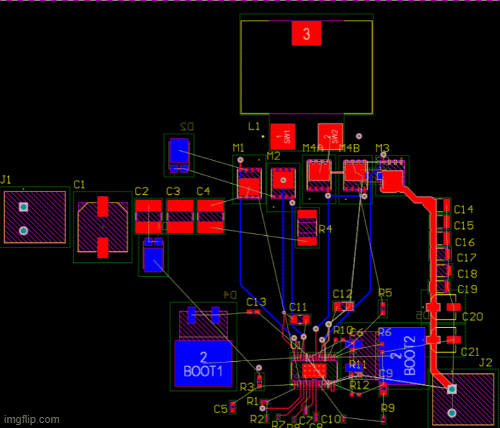
Timeline
The normal development for a product tends to range from months to years. For ALBATROSS, we only had 14 weeks to design, develop and test, and a lot happened in that short period of time. To help show the complications, successes and all the in-betweens, we have put together a timeline that illustrates the biggest milestones. For full descriptions of the entire development process, detailed reports can be found in Resources.

Week 1
ALBATROSS concept
Week 1 involved a lot of talking, brainstorming, and group task negotiation. This week we would establish a group contract that outlined team member responsibilities, place some initial component orders, and start researching design options.
Week 2
Proposing the Idea
The scope of our project came to shape in Week 2. "ALBATROSS is a computer capable of specialized tasks meant for use in emergency or off-grid applications while being operated either by battery power or a modular, multi-input, voltage regulated power supply."


Week 3
Project requirements established.
Once we had established our scope, and a draft of requirements, we would put together a larger document that would go over every single device requirement we could think of for ALBATROSS.
Week 4
Kiwix Comes Online
The first real milestone occurred during Week 4. We were able run Kiwix off of ALBATROSS! We were able to download Wikipedia and the D&D wiki directly onto ALABTROSS.


Synchronous Buck-Boost PCB Design Evolution
Week 5
PCB Design Begins
PCB design kicked off in week 5. Ruben was the most familiar with the circuit design and layout, so it made sense for him to work on the PCB design. However, he had no experience with the PCB design software, so he had to learn that first.
Week 6
Battery Pack Change
Week 6 saw our first major set back. Our originally plan for the ALBATROSS was for us to design and build our own battery pack. However, due to complications explained in our Progress Report and Final Reports, found in Resources, we had to rethink our strategy. We would end up purchasing a prebuilt pack online that would arrive during Week 7. We were now able to being the first set of major power tests.
Zeee Battery Pack inside ALBATROSS

First PCB prior to assembly
Week 8
GUI is Underway
While half our group worked on the power side of the project, the other half worked on both the software and antenna. Week 9 saw our GUI beginning to take shape. The vision we had initially laid out in weeks 1-3, was starting to come to fruition.

GUI's GPS Page

Week 9
First PCB Works!
After some troubleshooting, our first PCB starting functioning as expected on Nov 3rd. Now that we had both a working power supply and a battery, we could starting assembling and planning the internal connections of the ALBATROSS.
Power Supply Test Circuit
Week 10
Begin to Model Component Mounts and the Faceplate
As the weeks start disappear from under us, we realized we needed to start designing and preparing the internal structure of ALBATROSS. Week 10 saw the beginning of a multi-week project of designing and assembly the enclosures and mounts for each component within ALBATROSS.

Evolution of ALBATROSS's Faceplate

ALBATROSS's Charge Controller
Week 11
Charge Controller Works!
The final component of the power system within the ALBATROSS was a charge controller. After designing and assembling a new PCB, we were able to create a charge controller that would allow us to safety charge out battery. During Week 11, we would successfully test the charge controller, completing our power system. All that remains now for the power system are final tests and efficiency testing.
Week 12
System Efficiency Testing
With a fully functionally power system, we can run final tests and begin to test the overall efficiency of the ALBATROSS. Through weeks 12-14 we would run an array of stress tests, capacity tests and efficiency tests on the ALBATROSS's power system.


ALBATROSS's GUI
Week 13
GUI is Complete!
After many weeks of development, Week 13 saw ALABTROSS's GUI being finalized. For a more detailed description of the GUI, please refer to the Progress and Final Reports found in Resources.
Week 14
Decoded Satellite Data
A task we thought would take much less time, decoding the Satellite data was a constant problem we had. After multiple antenna prototypes, week 14 saw the final antenna iteration along with our best decoded weather data yet. For a more detailed description of the different antenna prototypes and the issues faced during their development, please refer to the Progress and Final Reports found in Resources.

Image received by ALBATROSS's Antenna

Weeks Beyond
The Future of ALBATROSS
We have many ideas on what we want to have future prototypes of ALBATROSS to contain.

